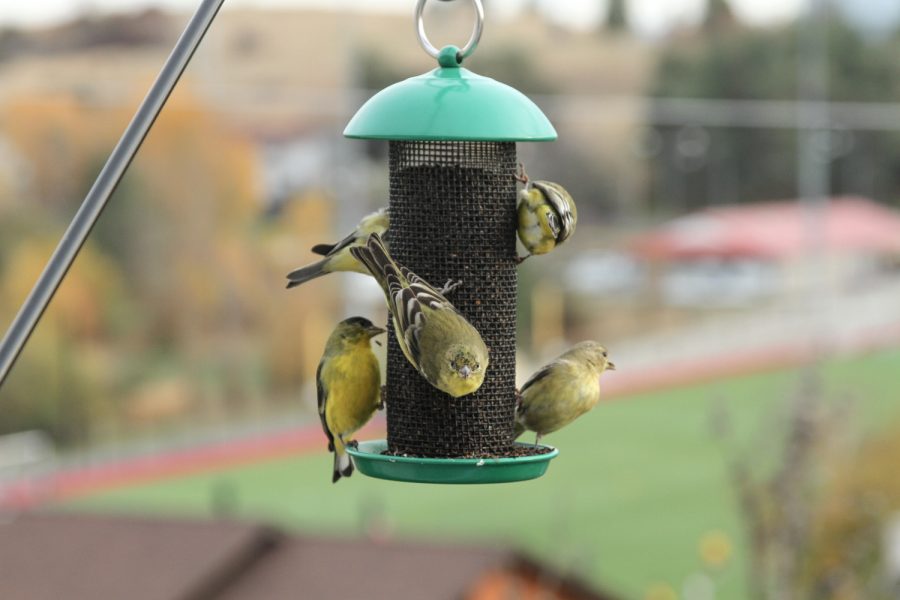Incentivize birds to visit, sing for you every morning
Bring the birds to you; no matter where you live, put out feeder or two!
A flock of lesser goldfinches rest on a thistle feeder on Nov. 2 in Pullman.
November 4, 2021
Their songs brighten the hours I do homework, and their shadows accompany me to class. Sometimes I catch a glimpse of one keeping an eye on me.
No matter where you live, birds are all around.
Birds are creatures of secrecy. However, once provided with an incentive to visit, they are creatures of habit. Each morning at sunrise, a small flock of lesser goldfinches shows up to enjoy breakfast at my thistle seed feeder.
Feeders are the best way to attract feathered friends. There are several main types of feeders: nectar, seed and suet. Pick a feeder depending on what species you’d like to see.
Nectar feeders attract hummingbirds, but you’re not as likely to see them heading into winter. They also require weekly cleaning to prevent the growth of toxic mold. Instead, I recommend tried and true seed feeders.
I have two seed feeders on my balcony: a thistle seed feeder and a mixed seed feeder. Thistle seed feeders are small and attract specialized species like house finches and goldfinches. Other birds have unsuitable beaks for thistle seed, so it deters big species that may bully the little guys out of the way.
My bigger seed feeder is filled with sunflower seeds and mixed birdseed. This feeder attracts a wider range of species, from song sparrows to red-winged blackbirds.
Although these feeders provide me with dependable entertainment during the spring and summer months, fall can never come too soon. Why? Fall heralds the start of suet season!
I know you’re not supposed to have favorites, but suet feeders are definitely my favorite. Suet cakes are a high-calorie blend of beef fat, nuts and seeds. Since suet is so nutritious, it’s the perfect food to keep birds warm through the winter.
Suet feeders attract black-capped chickadees and red-breasted nuthatches, who visit all day. These birds often don’t eat the suet right away. Instead, they plan ahead and stash it under some bark for chilly weather.
The most famous suet nibblers are woodpeckers. I’ve seen downy woodpeckers and northern flickers throughout campus, so there’s an exceptional chance of them visiting, no matter where you put out a suet feeder.
To bring the birds to you, put out a feeder or two! There are many types of hangers that secure bird feeders to your deck or balcony railing. Stand-alone feeder hangers can be placed anywhere. Some small feeders use suction cups to attach to a window, bringing your feathered visitors up close and personal.
The expenses for bird feeding are minimal. Feeders are reasonably priced and bird seed is quite affordable. You may be tempted to use nuts and seeds you have laying around, but don’t. Human food is harmful to birds.
Nuts and sunflower seeds we buy are salted, and fruit is coated in sugar. The biggest misconception is that you should feed birds bread. Don’t! Bread contains no nutritional value for birds and gets stuck in their beaks, which can cause infection and even beak loss.
Black oil sunflower seed, which attracts the largest variety of birds, tends to be on sale and a medium-size bag lasts me several months. Suet cakes are a couple bucks and last just as long. My feeders only need refilling every few weeks, unless a famished flock flies through.
Go ahead and get yourself a feeder. I promise it’ll pay off, and it’s always fun to spruce up your living space with a new feature. You’ll be enjoying live entertainment brought to you by nature in no time!


















